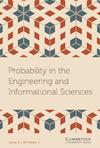随机多钩子网络
IF 1
3区 工程技术
Q4 ENGINEERING, INDUSTRIAL
Probability in the Engineering and Informational Sciences
Pub Date : 2022-05-02
DOI:10.1017/s0269964822000523
引用次数: 2
摘要
我们介绍了一类广泛的多钩网络,其中种子的多个副本在随机位置的每一步都被钩住,并且副本的数量遵循预定的构建序列。我们通过跟踪图中特定节点的局部平均度和全局平均度两种节点度来分析随机多钩网络的度分布。前者经历阶段,后者相对于建筑序列的类型是不变的,并且在某种程度上类似于初始种子的平均程度。我们还讨论了最小度节点的期望数目。此外,我们通过平均总路径长度、节点的平均深度、节点的偏心率和图的直径来研究网络中的距离。本文章由计算机程序翻译,如有差异,请以英文原文为准。
Random multi-hooking networks
We introduce a broad class of multi-hooking networks, wherein multiple copies of a seed are hooked at each step at random locations, and the number of copies follows a predetermined building sequence of numbers. We analyze the degree profile in random multi-hooking networks by tracking two kinds of node degrees—the local average degree of a specific node over time and the global overall average degree in the graph. The former experiences phases and the latter is invariant with respect to the type of building sequence and is somewhat similar to the average degree in the initial seed. We also discuss the expected number of nodes of the smallest degree. Additionally, we study distances in the network through the lens of the average total path length, the average depth of a node, the eccentricity of a node, and the diameter of the graph.
求助全文
通过发布文献求助,成功后即可免费获取论文全文。
去求助
来源期刊
CiteScore
2.20
自引率
18.20%
发文量
45
审稿时长
>12 weeks
期刊介绍:
The primary focus of the journal is on stochastic modelling in the physical and engineering sciences, with particular emphasis on queueing theory, reliability theory, inventory theory, simulation, mathematical finance and probabilistic networks and graphs. Papers on analytic properties and related disciplines are also considered, as well as more general papers on applied and computational probability, if appropriate. Readers include academics working in statistics, operations research, computer science, engineering, management science and physical sciences as well as industrial practitioners engaged in telecommunications, computer science, financial engineering, operations research and management science.

 求助内容:
求助内容: 应助结果提醒方式:
应助结果提醒方式:


